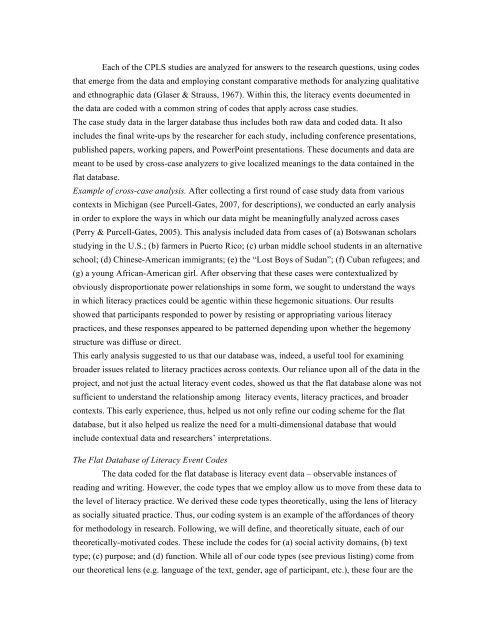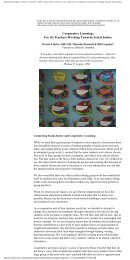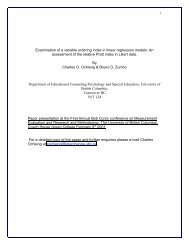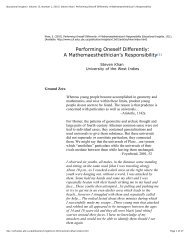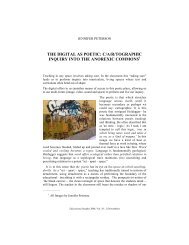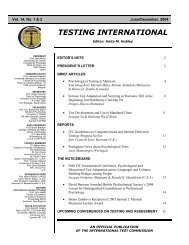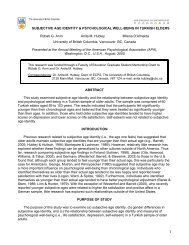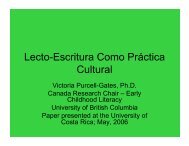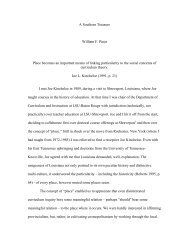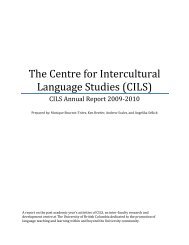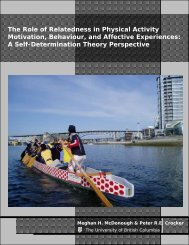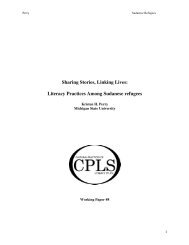Analyzing Literacy Practice - CPLS - University of British Columbia
Analyzing Literacy Practice - CPLS - University of British Columbia
Analyzing Literacy Practice - CPLS - University of British Columbia
You also want an ePaper? Increase the reach of your titles
YUMPU automatically turns print PDFs into web optimized ePapers that Google loves.
Each <strong>of</strong> the <strong>CPLS</strong> studies are analyzed for answers to the research questions, using codes<br />
that emerge from the data and employing constant comparative methods for analyzing qualitative<br />
and ethnographic data (Glaser & Strauss, 1967). Within this, the literacy events documented in<br />
the data are coded with a common string <strong>of</strong> codes that apply across case studies.<br />
The case study data in the larger database thus includes both raw data and coded data. It also<br />
includes the final write-ups by the researcher for each study, including conference presentations,<br />
published papers, working papers, and PowerPoint presentations. These documents and data are<br />
meant to be used by cross-case analyzers to give localized meanings to the data contained in the<br />
flat database.<br />
Example <strong>of</strong> cross-case analysis. After collecting a first round <strong>of</strong> case study data from various<br />
contexts in Michigan (see Purcell-Gates, 2007, for descriptions), we conducted an early analysis<br />
in order to explore the ways in which our data might be meaningfully analyzed across cases<br />
(Perry & Purcell-Gates, 2005). This analysis included data from cases <strong>of</strong> (a) Botswanan scholars<br />
studying in the U.S.; (b) farmers in Puerto Rico; (c) urban middle school students in an alternative<br />
school; (d) Chinese-American immigrants; (e) the “Lost Boys <strong>of</strong> Sudan”; (f) Cuban refugees; and<br />
(g) a young African-American girl. After observing that these cases were contextualized by<br />
obviously disproportionate power relationships in some form, we sought to understand the ways<br />
in which literacy practices could be agentic within these hegemonic situations. Our results<br />
showed that participants responded to power by resisting or appropriating various literacy<br />
practices, and these responses appeared to be patterned depending upon whether the hegemony<br />
structure was diffuse or direct.<br />
This early analysis suggested to us that our database was, indeed, a useful tool for examining<br />
broader issues related to literacy practices across contexts. Our reliance upon all <strong>of</strong> the data in the<br />
project, and not just the actual literacy event codes, showed us that the flat database alone was not<br />
sufficient to understand the relationship among literacy events, literacy practices, and broader<br />
contexts. This early experience, thus, helped us not only refine our coding scheme for the flat<br />
database, but it also helped us realize the need for a multi-dimensional database that would<br />
include contextual data and researchers’ interpretations.<br />
The Flat Database <strong>of</strong> <strong>Literacy</strong> Event Codes<br />
The data coded for the flat database is literacy event data – observable instances <strong>of</strong><br />
reading and writing. However, the code types that we employ allow us to move from these data to<br />
the level <strong>of</strong> literacy practice. We derived these code types theoretically, using the lens <strong>of</strong> literacy<br />
as socially situated practice. Thus, our coding system is an example <strong>of</strong> the affordances <strong>of</strong> theory<br />
for methodology in research. Following, we will define, and theoretically situate, each <strong>of</strong> our<br />
theoretically-motivated codes. These include the codes for (a) social activity domains, (b) text<br />
type; (c) purpose; and (d) function. While all <strong>of</strong> our code types (see previous listing) come from<br />
our theoretical lens (e.g. language <strong>of</strong> the text, gender, age <strong>of</strong> participant, etc.), these four are the


